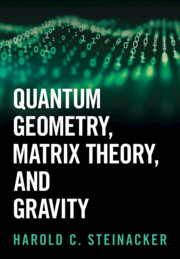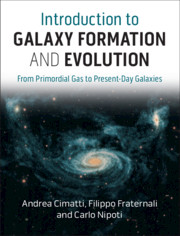Refine listing
Actions for selected content:
16933 results
Appendices
-
- Book:
- An Introduction to Gravity
- Published online:
- 04 May 2024
- Print publication:
- 11 April 2024, pp 276-310
-
- Chapter
- Export citation
Preface
-
- Book:
- Quantum Geometry, Matrix Theory, and Gravity
- Published online:
- 04 April 2024
- Print publication:
- 11 April 2024, pp xii-xvi
-
- Chapter
- Export citation
Index
-
- Book:
- An Introduction to Gravity
- Published online:
- 04 May 2024
- Print publication:
- 11 April 2024, pp 315-322
-
- Chapter
- Export citation
1 - Newtonian Gravity
-
- Book:
- An Introduction to Gravity
- Published online:
- 04 May 2024
- Print publication:
- 11 April 2024, pp 1-50
-
- Chapter
- Export citation
7 - Field Theories and Gravity
-
- Book:
- An Introduction to Gravity
- Published online:
- 04 May 2024
- Print publication:
- 11 April 2024, pp 247-275
-
- Chapter
- Export citation
2 - Transformation and Tensors
-
- Book:
- An Introduction to Gravity
- Published online:
- 04 May 2024
- Print publication:
- 11 April 2024, pp 51-101
-
- Chapter
- Export citation
Appendix A - Gaussian integrals over matrix spaces
-
- Book:
- Quantum Geometry, Matrix Theory, and Gravity
- Published online:
- 04 April 2024
- Print publication:
- 11 April 2024, pp 372-372
-
- Chapter
- Export citation

Quantum Geometry, Matrix Theory, and Gravity
-
- Published online:
- 04 April 2024
- Print publication:
- 11 April 2024

Introduction to Galaxy Formation and Evolution
- From Primordial Gas to Present-Day Galaxies
-
- Published online:
- 09 February 2024
- Print publication:
- 17 October 2019
-
- Textbook
- Export citation
Appendix A - A Possible Roadmap to Exobeings
-
- Book:
- Life and Language Beyond Earth
- Published online:
- 16 September 2023
- Print publication:
- 21 September 2023, pp 587-589
-
- Chapter
- Export citation
18 - Consciousness
- from Part IV - The Runaway Brain
-
- Book:
- Life and Language Beyond Earth
- Published online:
- 16 September 2023
- Print publication:
- 21 September 2023, pp 290-315
-
- Chapter
- Export citation
15 - The Brain-to-Body Relationship
- from Part IV - The Runaway Brain
-
- Book:
- Life and Language Beyond Earth
- Published online:
- 16 September 2023
- Print publication:
- 21 September 2023, pp 251-269
-
- Chapter
- Export citation
11 - The Slow Path of Evolution
- from Part III - Our Story on Earth
-
- Book:
- Life and Language Beyond Earth
- Published online:
- 16 September 2023
- Print publication:
- 21 September 2023, pp 143-163
-
- Chapter
- Export citation
Index
-
- Book:
- Life and Language Beyond Earth
- Published online:
- 16 September 2023
- Print publication:
- 21 September 2023, pp 661-672
-
- Chapter
- Export citation
19 - Artificial Intelligence
- from Part IV - The Runaway Brain
-
- Book:
- Life and Language Beyond Earth
- Published online:
- 16 September 2023
- Print publication:
- 21 September 2023, pp 316-326
-
- Chapter
- Export citation
Timelines
-
- Book:
- Life and Language Beyond Earth
- Published online:
- 16 September 2023
- Print publication:
- 21 September 2023, pp 616-623
-
- Chapter
- Export citation
17 - Our Cognition
- from Part IV - The Runaway Brain
-
- Book:
- Life and Language Beyond Earth
- Published online:
- 16 September 2023
- Print publication:
- 21 September 2023, pp 280-289
-
- Chapter
- Export citation
3 - Striving to Understand
- from Part I - Introduction
-
- Book:
- Life and Language Beyond Earth
- Published online:
- 16 September 2023
- Print publication:
- 21 September 2023, pp 31-44
-
- Chapter
- Export citation
Copyright page
-
- Book:
- Life and Language Beyond Earth
- Published online:
- 16 September 2023
- Print publication:
- 21 September 2023, pp iv-iv
-
- Chapter
- Export citation
7 - Possible Conditions on an Exoplanet
- from Part II - The Universe We Live In
-
- Book:
- Life and Language Beyond Earth
- Published online:
- 16 September 2023
- Print publication:
- 21 September 2023, pp 87-99
-
- Chapter
- Export citation
